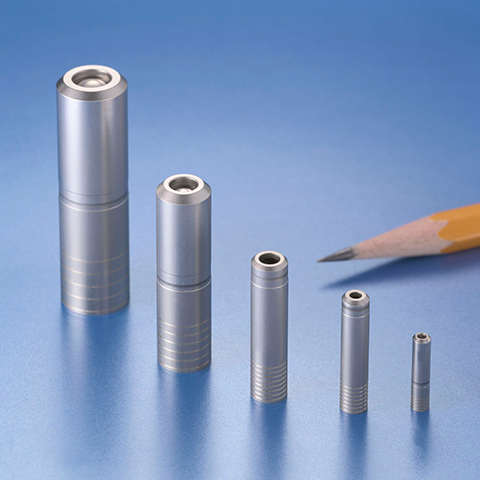
Posted to News on 23rd Feb 2022, 09:40
An engineer’s guide to selecting check valves

Specifying a check valve for a given application is no trivial task, with the design engineer needing to consider critical performance characteristics, environmental factors and performance trade-offs. We asked the experts at Lee Products for advice.
A check valve, also known as a non-return or one-way valve, is a mechanical device that allows a gas or liquid to flow freely in one direction while preventing reverse flow in the opposite direction. The purpose of a check valve in an application will determine some design parameters.
Generally, check valve functions can be divided into three categories: non-return, vent, and fill and drain. Non-return check valves allow flow in one direction with minimal pressure loss and prevent flow in the opposite direction. Vent check valves are designed to open and prevent pressure build-up in a system, while preventing flow in the checked, or non-return, direction. Fill and drain check valves permit fluid to flow into a system and prevent the fluid from escaping once it is filled.
Performance characteristics
There are several factors that must be considered to ensure the proper operation of a check valve within a system. These include system pressures, flow rate, leakage, cracking pressure, materials and envelope. Failure to consider these factors may lead to reduced valve or system performance, damage to other components within the system, or a total system failure.
System pressures: There are four pressure ratings that should be considered for any check valve: operating pressure, system pressure, proof pressure and burst pressure. Operating pressure is the pressure applied to the valve during normal operation throughout its life, both in the free flow direction and the checked direction. System pressure is the maximum nominal pressure achieved at the valve’s location within the system.
Proof pressure is the pressure the valve can withstand without permanent deformation or degradation of performance when the system returns to operating pressure. Burst pressure is the pressure at which the valve can survive without rupturing or bursting. All four pressure ratings must be considered during design to ensure the valve and its components are sufficiently durable for the application.
Flow rate: In order to perform its function in an efficient manner, a hydraulic system requires a precise volume of fluid within a specific period of time. A check valve will create an added restriction within the system, so the system designer must specify the necessary flow rate through the valve. The flow rate is typically specified at a point above the cracking pressure when the valve is in its fully open state—also known as the flow point pressure or free flow point.
Leakage: Valve leakage can be broken down into two categories: external and internal. External leakage refers to fluid flowing around the exterior of the valve body, which may include threads, O-ring seals, or other external features. Internal leakage is any fluid flow through the valve’s body while the valve is in its closed position, specifically in the checked direction for a check valve. Leakage allowances can be influenced by variables such as an open or closed system, fluid supply and volume, and desired system efficiency.
Cracking pressure: A check valve’s opening pressure, or cracking pressure, is the pressure at which the valve opens and begins to allow fluid to pass. The cracking pressure is based on the pressure vessel or system’s design criteria; it is typically defined as a nominal pressure with a tolerance or as a maximum.
The pressure may be controlled by the spring force used to bias the valve closed or by the material properties and configuration of a diaphragm. Some check valves include free-floating seals and have zero cracking pressure. Increased cracking pressure is desirable to avoid potential damage caused by fluid flow in the checked direction should external forces, such as a shock or vibration, cause the valve to open despite fluid pressure in the checked direction.
Materials: A check valve is comprised of several sub-components. The materials of each component must be able to withstand the various forces that will be applied to them during the valve’s operating life. Materials must also be compatible with their environment, and the valve’s materials should be considered when determining how the valve will be installed into the system. Failure to consider material compatibility may create issues related to thermal expansion and corrosion.
Envelope: The first consideration here is the location of the valve within the system and the desired flow path for the free flow fluid. The system may require the check valve to be located within a specific area, limiting external dimensions or overall size. The location may also dictate the flow path of the free flow fluid based on existing lines. The envelope must also account for installation, retention, and maintenance requirements. Finally, evaluate if the valve may be used in a system in which weight is a factor, such as a portable system.
Environmental considerations
After determining the required performance characteristics of a check valve, it is critical to identify other variables that will influence the valve’s performance. The internal and external environment of the system will affect the valve’s performance in a variety of ways, impacting every aspect of its functionality and limiting options for the valve’s construction.
Operating fluid: The performance of a check valve is greatly affected by the operating fluid’s viscosity and specific gravity. The operating fluid also introduces other variables that must be considered, such as material compatibility. A fluid that is incompatible with the valve’s materials could cause damage to the valve and impact its performance. It is also possible that the valve’s materials may alter the fluid’s properties, negatively affecting system performance.
Operating life: It is important to consider how long the valve must withstand the conditions it will be exposed to during operation. This includes both the maximum length of time the valve shall be in service and number of cycles the valve performs. A check valve may experience wear due to exposure to its environment or by forces caused by contact of internal components, particularly between the sealing components. Excessive wear on the valve’s components over an extended operating life could lead to performance or installation and retention issues.
Temperature: Both the temperature of the fluid and the ambient temperature can impact the performance of a check valve. Changes to the temperature of the fluid will alter the fluid’s properties, including viscosity and specific gravity, impacting flow. Leakage rates may be higher as temperatures increase because it is more difficult to seal against a thinner fluid.
Temperatures also impact decisions about the materials used in the check valve. At cold temperatures, some materials become brittle, while at elevated temperatures, materials may become soft or melt. These changes can reduce a valve’s operating life.
External pressures: Check valve performance is typically based around pressures within the system. However, the check valve envelope may be subject to other environmental pressures, such as those found deep underwater, underground, or even the absence of pressure found in outer space.
Vibration, shock, and g-forces: Check valves can be subject to forces external to the system in which it is installed, as well as the forces generated by operation of the system. These forces are typically vibration, shock, and g-forces. The magnitude, frequency, and direction of the potential forces must be considered, with the internal components of the valve possibly moving differently based on the direction of the force. The frequency may have a different impact based on the spring rate in the valve.
Cleanliness: A check valve may have trace amounts of fluids, debris, or dust on or within the valve. This contamination may be caused by the processes used to manufacture the valve or the environment it is subjected to during manufacturing, transportation, or storage. In most cases, the trace amount of contamination that is present on the valve at the completion of production is acceptable. If the end user cannot tolerate the presence of this level of contamination, the valve may need to go through special cleaning and packaging processes.
Performance trade-offs
After determining the optimal performance requirements and the environmental factors that will impact performance, the next step is to select or design an appropriate check valve for the application. Unfortunately, it may be challenging to find a solution that meets every requirement.
As with most decisions, there are trade-offs that must be considered. Some of these trade-offs are common sense. For example, decreasing the valve’s envelope size may result in a lower flow capacity. Changing the valve’s material from plastic to metal will increase operating or burst pressure capability but will impact the valve’s weight. There are other performance aspects specific to check valves that may require more careful consideration during the selection process.
Gain: Valve gain is defined as the rate of increase in flow rate per increase in pressure; it is a measure of how efficiently a valve moves from a closed position to the flow point pressure. A high-gain valve is one that can fully open with minimal increase in pressure. A low-gain valve requires a more significant increase in pressure to achieve the fully open condition. However, a lower gain valve may offer greater stability when the system’s flow rate is too low to fully open the check valve.
Response time: The response time indicates how quickly a check valve goes from a state of free flow to fully closed; this occurs when pressure reverses and generates a pressure differential in the checked direction. Response time may be important when the direction of pressure changes quickly and increases at an extremely high rate.
A valve with a slow response time to a rapid pressure reversal and high rise rate may briefly allow flow and pressure in the checked direction until the valve closes. This may negatively affect system performance or may even cause damage to upstream components the check valve is intended to protect.
Seal materials: Valve materials were previously discussed in relation to their ability to withstand the required environment. There are also significant performance trade-offs related to the choice of materials for sealing components. Seals made of harder material, such as metal, are often able to withstand higher pressure and wider temperature ranges than seals made of softer materials, such as plastic or rubber.
However, the softer materials are often capable of providing tighter leakage control. Leakage will also vary based on the force applied to the seals. Selecting materials that offer the necessary balance between leakage rate, pressure range, temperature range, and durability is critical to system performance.






